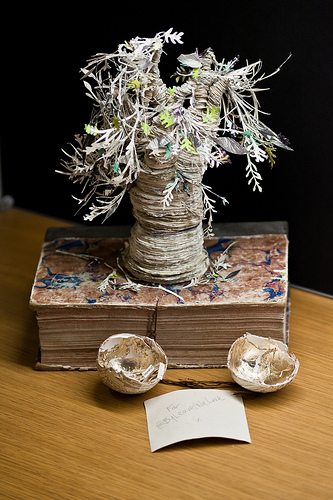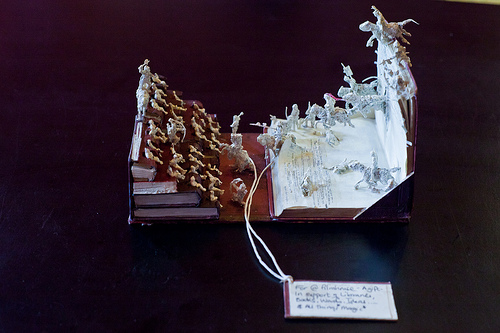
Making sense of the misty ideas floating around my head can be hard, so I will do my best to make this post intelligible. So much of what this blog is about and what I truly love is the hunt, the surprise, the excitement of a found object, a piece of art, or a moment or item of beauty in a place least expected. Along those lines it is no surprise that my family, led by my girls, but with the mantle well taken up by me, has become addicted to geocaching. If you haven’t heard of it, geocaching is an outdoor hobby in which the participants use a Global Positioning System receiver and other navigational techniques to hide and seek containers, called “geocaches” or “caches”, anywhere in the world (thanks Wikipedia). When you find a cache, you leave a tiny gift inside and choose one to take that has been left there previously. Sometimes there is even a special trackable item with a mission such as “travel around the globe” and the job of the finder is to move that item onwards in its journey. For the kids, the math, geography and the actual search are challenging and fun, but for me it is truly that eureka(!) moment that makes it so irresistible. The whole idea of it is like a net that binds a mass of strangers together, almost a form of performance art. We had just started in New Jersey this summer, but now have been working our way through our neighborhood here in Tokyo as well as further afield. I feel like I need to add it as a tip to my post on antiquing with kids – or actually just as plain old parenting advice. Add a geocache site to your day and it will keep any child happy doing even boring errands.
We are making sure to addict our friends too as there is no fun in going it alone. Recently, one of those friends whom we introduced to geocaching and who also happens to be from Corning, NY, glass capital of the world, introduced a glass artist to me – Josh Simpson – who makes tiny miniature worlds and then leaves them places for people to stumble upon, whether it be in a few weeks or hundreds of years. Josh writes, “In 1976 I discovered several handmade marbles outside my kitchen door. Probably left there by children a generation before, they were still just as bright and colorful as they were on the summer afternoon they were lost.” His fascination with them led him to begin his Infinity Project, making and hiding tiny glass worlds and then, through the help of a few thousand volunteers, hiding them all over the world. “I hope future archaeologists will be confused about the meaning and purpose of the little spheres, wondering what they are and how they got there.”
Simpson’s website is full of photos of these amazing worlds, some tiny and some very large. My kids think they are amazing and love to study them and make comparisons with our own planet. My littlest one even kind of believes there are tiny little people in them and asks if it is possible that we are really in a glass sculpture and don’t know it. Simpson says, “the cores of Planets are full of bubbles, threads, and kaleidoscopic patterns evoking unseen landscapes and underwater worlds. I know I’ve succeeded when you feel like you have to look closer at one of my little worlds and then lose yourself in its textures and color.”
One of my favorite photos from his site shows the glass canes that must get embedded in the globes (forgive me if I am completely wrong about that technique). I find them very mysterious….What do you see when you look at them? (I see coral reefs).
Hunting for glass balls is something we are already very familiar with as we are also perpetually on the lookout for old Japanese glass fishing floats. My elder daughter has taken to this one in particular, learning the marks and history and begging to drive nine hours north to the tip of Japan for our vacation in order to look for them on the beaches there. Last weekend, we went out searching with friends as part of a jaunt along the nearby coast, only to discover a few beloved “lucky” floats that no fishermen were willing to part with. Nonetheless, just finding things has a magic of its own.
Exploring by flashlight was quite exciting.
Our actual haul to date has been pretty good – this isn’t even all we have found. Like any enthusiasts, glass float collectors talk lovingly about bubbles, swirls and spindles. Rare marks and shapes are all the more collectible. Give her a minute and my daughter will be happy to talk your ear off.
Another friend turned me on the annual “Finders Keepers” event in Lincoln City, Oregon, in which local artists hand blow and hide roughly 2000 floats along the beach every winter for people to discover. It has become a huge tourist attraction that pulls folks in and gets them to tour the art galleries as well as hunt on the beach. Again, like Simpson’s tiny glass worlds, this is art that allows the viewer to participate in such that they become part of it.
Late this summer there was also a special glass drop in which 200 small antique Japanese glass floats were planted along the Lincoln City beaches. Won’t mention that to my daughter…
But perhaps the most unusual found items of late are these extraordinary and minutely detailed paper sculptures being anonymously left at numerous Scottish libraries. Each one is absolutely amazing in both its construction and wittiness, but it is a complete mystery as to who has been making them. I cannot resist showing them all, in the order they have been found, but for more information on the story and wonderful close-ups see Txikito Planet.
The tag on the first one left at the Scottish Poetry Library in March read:
It started with your name @byleaveswelive and became a tree.…
… We know that a library is so much more than a building full of books… a book is so much more than pages full of words.…
This is for you in support of libraries, books, words, ideas….. a gesture (poetic maybe?)
Next up was this gramophone over a coffin deposited at the National Library of Scotland:
For @natlibscot – A gift in support of libraries, books, words, ideas….. (& against their exit)
The third was found at the Filmhouse theater:
For @filmhouse – A gift in support of libraries, books, words, ideas….. and all things *magic*
I thought the one left at the Scottish Storytelling Centre was my favorite. The tag reads:
For @scotstorycenter – A gift in support of libraries, books, works, ideas….. Once upon a time there was a book and in the book was a nest and in the nest was an egg and in the egg was a dragon and in the dragon was a story…..
But in sentiment it may have been replaced by this one appearing at the Edinburgh International Book Festival which reads “Nothing beats a nice cup of tea (or coffee) and a really good BOOK, except maybe a cake as well“. The attached tag:
To @edbookfest ‘A gift’ This is for you in support of libraries, books, words, ideas…… & festivals xx
This one also appeared at the festival with the following tag:
To @edincityoflit ‘A gift’ LOST (albeit in a good book) This is for you in support of libraries, books, words, ideas…. “No infant has the power of deciding….. by what circumstances (they) shall be surrounded.. Robert Owen
The final one I have seen appeared at the Central Lending Library at the end of August.
For Central Library ‘A Gift’ @Edinburgh_CC This is for you in support of libraries, books, words, ideas…. LIBRARIES ARE EXPANSIVE. Note the letter change in the last word.
In late September the mystery was solved, with the Edinburgh News taking a poll as to whether or not to reveal the artist’s name. As far as I know, it is still not public knowledge. I think it is more fun to keep the mystery alive!
As for us, my girls are hoping to convince Josh Simpson that we should be the next participants in his Infinity Project. They want to hide one of his tiny worlds in a geocache and give it an assignment in the hopes that fellow geocachers will carry it from place to place, creating a traveling art exhibition of one.
Image credits: 1. G. Fukuda via Instagram, 2. Hector Rodriguez via Josh Simpson, 3-4. Josh Simpson, 5-7 & 9. me, 8. via oregon.com, 10-16. chrisdonia via Txikito Planet















